Aliinostoc bakau sp. nov. (Cyanobacteria, Nostocaceae), a New Microcystin Producer from Mangroves in Malaysia
Abstract
1. Introduction
2. Materials and Methods
2.1. Site Description and Sampling
2.2. Culture Establishment
2.3. Morphological Characterisation
2.4. Molecular Analyses
2.5. Screening for Cyanotoxin Genes
2.6. Phylogenetic Analysis and ITS Folding
3. Results
3.1. Phylogenetic Analysis
3.2. ITS Secondary Structure
3.3. Microcystin Production from A. bakau
4. Discussion
Author Contributions
Funding
Institutional Review Board Statement
Data Availability Statement
Acknowledgments
Conflicts of Interest
References
- Alongi, D.M. A simple mass balance framework for estimating limits to sustainable mangrove production: Some examples from managed forests in Southeast Asia. Cyanobacteria in Extreme Environments. Int. J. Eco. Environ. Sci. 2005, 11, 209–224. [Google Scholar]
- Sundararaman, M.; Boopathi, T.; Gopinath, S. Status of mangrove ecosystem: Exploring the potential role of cyanobacteria in restoration and afforestation. Algae Int. J. Ecol. Environ. Sci. 2007, 31, 147–155. [Google Scholar]
- Rigonato, J.; Kent, A.D.; Alvarenga, D.O.; Andreote, F.D.; Beirigo, R.M.; Vidal-Torrado, P.; Fiore, M.F. Drivers of cyanobacterial diversity and community composition in mangrove soils in south-east Brazil. Environ. Microbiol. 2013, 15, 1103–1114. [Google Scholar] [CrossRef]
- Essien, J.P.; Antai, S.P.; Benson, N.U. Microalgae biodiversity and biomass status in Qua Iboe Estuary mangrove swamp, Nigeria. Aquat. Ecol. 2008, 42, 71–81. [Google Scholar] [CrossRef]
- Dadheech, P.K.; Glöckner, G.; Casper, P.; Kotut, K.; Mazzoni, C.J.; Mbedi, S.; Krienitz, L. Cyanobacterial diversity in the hot spring, pelagic and benthic habitats of a tropical soda lake. FEMS Microbiol. Ecol. 2013, 85, 389–401. [Google Scholar] [CrossRef]
- Alvarenga, D.O.; Rigonato, J.; Branco, L.H.Z.; Fiore, M.F. Cyanobacteria in mangrove ecosystems. Biodivers. Conserv. 2015, 24, 799–817. [Google Scholar] [CrossRef]
- Bianchi, M.C.G.; Chopin, F.; Farme, T.; Franz, N.; Fuentevilla, C.; Garibaldi, L.; Laurenti, A.L.G. The State of World Fisheries and Aquaculture; Food and Agriculture Organization of the United Nations: Rome, Italy, 2014. [Google Scholar]
- Abu Hena, M.K.; Idris, M.H.; Rajaee, A.H.; Siddique, M.A.M. Length-weight relationships of three fish species from a tropical mangrove estuary of Sarawak, Malaysia. J. Appl. Ichthyol. 2017, 33, 858–860. [Google Scholar] [CrossRef]
- Azmir, I.A.; Esa, Y.; Amin, S.M.N.; Md Yasin, I.S.; Md Yusof, F.Z. Identification of larval fish in mangrove areas of Peninsular Malaysia using morphology and DNA barcoding methods. J. Appl. Ichthyol. 2017, 33, 998–1006. [Google Scholar] [CrossRef]
- Singh, H.R.; Baharin, N.K. Gastropod community structure from varying levels of mangrove disturbance in Selangor, Malaysia. Malays. For. 2016, 79, 54–63. [Google Scholar]
- Ismail, M.H.; Chong, V.C.; Ramli, R.; Sasekumar, A. Rediscovery of Ellobium scheepmakeri (Petit De La Saussaye, 1850) (Mollusca: Gastropoda: Ellobiidae), a rare ellobiid in Bukit Belimbing mangrove forest, Peninsular Malaysia. Molluscan Res. 2017, 37, 222–226. [Google Scholar] [CrossRef]
- Vaezzadeh, V.; Zakaria, M.P.; Bong, C.W. Aliphatic hydrocarbons and triterpene biomarkers in mangrove oyster (Crassostrea belcheri) from the west coast of Peninsular Malaysia. Mar. Pollut. Bull. 2017, 124, 33–42. [Google Scholar] [CrossRef]
- Noor Jawahir, A.R.; Samsur, M.; Shabdin, M.L.; Khairul Adha, A.R. Distribution of two species of Asian horseshoe crabs at west coast of Sarawak’s Waters, East Malaysia. Egypt. J. Aquat. Res. 2017, 43, 135–140. [Google Scholar] [CrossRef]
- Sharif, N.; Kahar, N.; Rodrigues, K.; Ransangan, J.; Kian, A. 2016. Genetic diversity of mud crabs, Scylla tranquebarica in Sabah, Malaysia based on cytochrome C oxidase (COI) gene sequence. Songklanakarin J. Sci. Technol. 2016, 38, 365–372. [Google Scholar]
- Le, Q.D.; Haron, N.A.; Tanaka, K.; Ishida, A.; Sano, Y.; Dung, L.V.; Shirai, K. Quantitative contribution of primary food sources for a mangrove food web in Setiu lagoon from East coast of Peninsular Malaysia, stable isotopic (δ13C and δ15N) approach. Reg. Stud. Mar. Sci. 2017, 9, 174–179. [Google Scholar] [CrossRef]
- Azman, A.S.; Zainal, N.; Mutalib, N.S.A.; Yin, W.F.; Chan, K.G.; Lee, L.H. Monashia flava gen. nov., sp. nov. An actinobacterium of the family Intrasporangiaceae. Int. J. Syst. Evol. Microbiol. 2016, 66, 554–561. [Google Scholar] [CrossRef]
- Law, J.W.F.; Ser, H.L.; Duangjai, A.; Saokaew, S.; Bukhari, S.I.; Khan, T.M.; Ab Mutalib, N.S.; Chan, K.G.; Goh, B.H.; Lee, L.H. Streptomyces colonosanans sp. nov., a novel actinobacterium isolated from Malaysia mangrove soil exhibiting antioxidative activity and cytotoxic potential against human colon cancer cell lines. Front. Microbiol. 2017, 8, 877. [Google Scholar] [CrossRef]
- Moh, T.H.; Lau, N.S.; Furusawa, G.; Amirul, A.A.A. Complete genome sequence of Microbulbifer sp. CCB-MM1, a halophile isolated from Matang Mangrove Forest, Malaysia. Stand. Genom. Sci. 2017, 12, 36. [Google Scholar] [CrossRef]
- Auta, H.S.; Emenike, C.U.; Fauziah, S.H. Screening of Bacillus strains isolated from mangrove ecosystems in Peninsular Malaysia for microplastic degradation. Environ. Pollut. 2017, 231, 1552–1559. [Google Scholar] [CrossRef]
- Aikanathan, S.; Sasekumar, A. The community structure of macroalgae in a low shore mangrove forest in Selangor, Malaysia. Hydrobiologia 1994, 285, 131–137. [Google Scholar] [CrossRef]
- Billah, M.M.; Kamal, A.H.M.; Idris, M.H.B.; Ismail, J.B. Seasonal variation in the occurrence and abundance of mangrove macroalgae in a Malaysian Estuary. Cryptogam. Algol. 2016, 37, 109–120. [Google Scholar] [CrossRef]
- Md Isa, H.; Mustafa Kamal, A.H.; Idris, M.H.; Rosli, Z.; Ismail, J. Biomass and habitat characteristics of epiphytic macroalgae in the Sibuti Mangroves, Sarawak, Malaysia. Trop. Life Sci. Res. 2017, 28, 1–21. [Google Scholar] [CrossRef]
- Tan, S.N.; Teng, S.T.; Lim, H.C.; Kotaki, Y.; Bates, S.S.; Leaw, C.P.; Lim, P.T. Diatom Nitzschia navis-varingica (Bacillariophyceae) and its domoic acid production from the mangrove environments of Malaysia. Harmful Algae 2016, 60, 139–149. [Google Scholar] [CrossRef]
- Mani, P. Natural phytoplankton communities in Pichavaram mangroves. Ind. J. Mar. Sci. 1992, 21, 278–280. [Google Scholar]
- Nagasathya, A.; Thajuddin, N. Cyanobacterial diversity in the hypersaline environment of the saltpans of south eastern coast of India. Asian J. Plant Sci. 2008, 7, 473–478. [Google Scholar] [CrossRef][Green Version]
- Silambarasan, G.; Ramanathan, T.; Kathiresan, K. Diversity of marine cyanobacteria from three mangrove environment in Tamil Nadu Coast, south east coast of India. Curr. Res. J. Biol. Sci. 2012, 4, 235–238. [Google Scholar]
- Sakthivel, K.; Kathiresan, K. Cyanobacterial diversity from mangrove sediment of south east coast of India. Asian J. Biodivers. 2013, 4, 190–203. [Google Scholar] [CrossRef]
- Nogueira, N.M.C.; Ferreira-Correia, M.M. Cyanophyceae/Cyanobacteria in red mangrove forest at mosquitos and coqueiros estuaries, São Luís, state of Maranhão, Brazil. Braz. J. Biol. 2001, 61, 347–356. [Google Scholar] [CrossRef]
- Rigonato, J.; Alvarenga, D.O.; Andreote, F.D.; Dias, A.C.F.; Melo, I.S.; Kent, A.; Fiore, M.F. Cyanobacterial diversity in the phyllosphere of a mangrove forest. FEMS Microbiol. Ecol. 2012, 80, 312–322. [Google Scholar] [CrossRef]
- Silva, C.S.P.; Genuario, D.B.; Vaz, M.G.M.V.; Fiore, M.F. Phylogeny of culturable cyanobacteria from Brazilian mangroves. Syst. Appl. Microbiol. 2014, 37, 100–112. [Google Scholar] [CrossRef]
- Kyaruzi, J.J.; Kyewalyanga, M.S.; Muruke, M.H.S. Cyanobacteria composition and impact of seasonality on their in-situ nitrogen fixation rate in a mangrove ecosystem adjacent to Zanzibar town. West Indian Ocean. J. Mar. Sci. 2003, 2, 35–44. [Google Scholar] [CrossRef]
- Hussain, M.I.; Khoja, T.M. Intertidal and subtidal blue-green algal mats of open and mangrove areas in the Farasan Archipelago (Saudi Arabia), Red Sea. Bot. Mar. 1993, 36, 377–388. [Google Scholar] [CrossRef]
- Harith, M.N.; Hassan, R. Preliminary study on cyanobacteria composition and selected water quality parameters from freshwater fish (Tor tambroides) ponds in Serian, Sarawak. In Proceedings of the Natural Resources and Environmental Management and Environmental Safety and Health (NREM & ESH), Kuching, Sarawak, Malaysia, 27–29 November 2007. [Google Scholar]
- Harith, M.N.; Hassan, R. Diversity and similarity among cyanobacteria assemblages from selected aquatic ecosystems in Sarawak using β—indices. Borneo J. Res Sci. Technol. 2011, 1, 28–37. [Google Scholar] [CrossRef]
- Sinang, S.C.; Poh, K.B.; Shamsudin, S.; Sinden, A. Preliminary assessment of cyanobacteria diversity and toxic potential in ten freshwater lakes in Selangor, Malaysia. Bull. Environ. Contam. Toxicol. 2015, 95, 542–547. [Google Scholar] [CrossRef]
- Sinden, A.; Sinang, S.C. Presence and abundance of cyanobacteria in selected aquaculture ponds in Perak, Malaysia and the relationships with selected physicochemical parameters of water. J. Teknol. 2015, 76, 187–194. [Google Scholar] [CrossRef][Green Version]
- Azizan, A.A.; Radzi, R.; Omar, W.M.W.; Convey, P.; Merican, F.M.M.S. First records of morphological diversity and ecology of periphytic cyanobacteria from Tukun River, Penang Forest Reserve, Malaysia. Trop. Life Sci. 2020, 31, 85–105. [Google Scholar] [CrossRef]
- Codd, G.A.; Morrison, L.F.; Metcalf, J.S. Cyanobacterial toxins: Risk management for health protection. Toxicol. Appl. Pharmacol. 2005, 203, 264–272. [Google Scholar] [CrossRef]
- Falconer, I.R.; Humpage, A.R. Health risk assessment of cyanobacterial (blue-green algal) toxins in drinking water. Int. J. Environ. Res. Public Health 2005, 2, 43–50. [Google Scholar] [CrossRef]
- Steffensen, D.; Burch, M.; Nicholson, B.; Drikas, M.; Baker, P. Management of toxic blue-green algae (cyanobacteria) in Australia. Environ. Toxicol. 1999, 14, 183–195. [Google Scholar] [CrossRef]
- Stewart, I.; Seawright, A.A.; Shaw, G.R. Cyanobacterial poisoning in livestock, wild mammals, and birds—An overview. In Cyanobacterial Harmful Algal Blooms: State of the Science and Research Needs; Hudnell, H.K., Ed.; Springer: New York, NY, USA, 2008; pp. 613–637. [Google Scholar]
- Quiblier, C.; Wood, S.A.; Echenique-Subiabre, I.; Heath, M.; Villeneuve, A. A review of current knowledge on toxic benthic freshwater cyanobacteria–ecology, toxin production and risk management. Water Res. 2013, 47, 5464–5479. [Google Scholar]
- Ikehara, T.; Kuniyoshi, K.; Yamaguchi, H.; Tanabe, Y.; Sano, T.; Yoshimoto, M.; Oshiro, N.; Nakashima, S.; Yasumoto-Hirose, M. First report of Microcystis strains producing MC-FR and-WR Toxins in Japan. Toxins 2019, 11, 521. [Google Scholar] [CrossRef]
- Sivonen, K.; Börner, T. Bioactive compounds produced by cyanobacteria. In The Cyanobacteria: Molecular Biology, Genomic and Evaluation; Herrero, A., Flores, E., Eds.; Caister Academic Press: Hethersett, UK, 2008; pp. 159–197. [Google Scholar]
- Fiore, M.F.; Genuário, D.B.; da Silva, C.S.P.; Shishido, T.K.; Moraes, L.A.B.; Neto, R.C.; Silva-Stenico, M.E. Microcystin production by a freshwater spring cyanobacterium of the genus Fischerella. Toxicon 2009, 53, 754–761. [Google Scholar] [CrossRef]
- Catherine, A.; Bernard, C.; Spoof, L.; Bruno, M. Microcystins and nodularins. In Handbook of Cyanobacterial Monitoring and Cyanotoxin Analysis; Meriluoto, J., Spoof, L., Codd, G.A., Eds.; John Wiley & Sons: Chichester, UK, 2017; pp. 109–126. [Google Scholar]
- Bagchi, S.N.; Dubey, N.; Singh, P. Phylogenetically distant clade of Nostoc-like taxa with the description of Aliinostoc gen. nov. and Aliinostoc morphoplasticum sp. nov. Int. J. Syst. Evol. Microb. 2017, 67, 3329–3338. [Google Scholar] [CrossRef] [PubMed]
- Kabirnataj, S.; Nematzadeh, G.A.; Talebi, A.F.; Saraf, A.; Suradkar, A.; Tabatabaei, M.; Singh, P. Description of novel species of Aliinostoc, Desikacharya and Desmonostoc using a polyphasic approach. Int. J. Syst. Evol. Microb. 2020, 70, 3413–3426. [Google Scholar] [CrossRef] [PubMed]
- Saraf, A.; Dawda, H.G.; Suradkar, A.; Behere, I.; Kotulkar, M.; Shaikh, Z.M.; Kumat, A.; Batule, P.; Mishra, D.; Singh, P. Description of two new species of Aliinostoc and one new species of Desmonostoc from India based on the polyphasic approach and reclassification of Nostoc punensis to Desmonostoc punense comb. nov. FEMS Microbiol. Lett. 2018, 365, fny272. [Google Scholar] [CrossRef]
- Lee, N.J.; Bang, S.D.; Kim, T.; Ki, J.S.; Lee, O.M. Pseudoaliinostoc sejongens gen. & sp. nov. (Nostocales, Cyanobacteria) from floodplain soil of the Geum River in Korea based on polyphasic approach. Phytotaxa 2021, 479, 55–70. [Google Scholar]
- Christodoulou, M.; Jokela, J.; Wahlsten, M.; Saari, L.; Economou-Amilli, A.; Fiori, M.d.L.; Sivonen, K. Description of Aliinostoc alkaliphilum sp. nov. (Nostocales, Cyanobacteria), a new bioactive metabolite-producing strain from Salina Verde (Pantanal, Brazil) and taxonomic distribution of bioactive metabolites in Nostoc and Nostoc-like genera. Water 2022, 14, 2470. [Google Scholar]
- Maltseva, S.; Kezlya, E.; Krivova, Z.; Gusev, E.; Kulikovskiy, M.; Maltsev, Y. Phylogeny and fatty acid profiles of Aliinostoc vietnamicum sp. nov. (Cyanobacteria) from the soils of Vietnam. J. Phycol. 2022, 58, 789–803. [Google Scholar] [CrossRef]
- Guidi-Rontani, C.; Jean, M.R.; Gonzalez-Rizzo, S.; Bolte-Kluge, S.; Gros, O. Description of new filamentous toxic Cyanobacteria (Oscillatoriales) colonizing the sulfidic periphyton mat in marine mangroves. FEMS Microbiol. Lett. 2014, 359, 173–181. [Google Scholar] [CrossRef]
- Mohamed, Z.A.; Al-Shehri, A.M. Biodiversity and toxin production of cyanobacteria in mangrove swamps in the Red Sea off the southern coast of Saudi Arabia. Bot. Mar. 2015, 58, 23–34. [Google Scholar] [CrossRef]
- Mohamed, Z.A.; Hashem, M.; Alamri, S.; Mostafa, Y. Cyanotoxins and their environmental health risk in marine and freshwaters of Saudi Arabia. Arab. J. Geosci. 2020, 13, 285. [Google Scholar] [CrossRef]
- Zaheri, A.; Bahador, N.; Yousefzadi, M.; Arman, M. Molecular identification and toxicity effects of cyanobacteria species isolated from the Khoor-e-Khooran mangrove forest, Persian Gulf. Iran. J. Fish. Sci. 2021, 20, 572–589. [Google Scholar]
- Turland, N.J.; Wiersema, J.H.; Barrie, F.R.; Greuter, W.; Hawksworth, D.L.; Herendeen, P.S.; Knapp, S.; Kusber, W.-H.; Li, D.-Z.; Marhold, K.; et al. (Eds.) International Code of Nomenclature for Algae, Fungi, and Plants (Shenzhen Code): Adopted by the Nineteenth International Botanical Congress, Shenzhen, China, July 2017; Koeltz Botanical Books: Glashütten, Germany, 2018. [Google Scholar]
- Rippka, R.; Deruelles, J.; Waterbury, J.B.; Herdman, M.; Stanier, R.Y. Generic assignments, strain histories and properties of pure cultures of cyanobacteria. J. Gen. Microbiol. 1979, 111, 1–61. [Google Scholar] [CrossRef]
- Bolch, C.J.; Blackburn, S.I. Isolation and purification of Australian isolates of the toxic cyanobacterium Microcystis aeruginosa Kütz. J. Appl. Phycol. 1996, 8, 5–13. [Google Scholar] [CrossRef]
- Guiry, M.D.; Guiry, G.M. AlgaeBase. Available online: https://www.algaebase.org (accessed on 5 November 2023).
- Komárek, J. Modern classification of cyanobacteria. In Cyanobacteria: An Economic Perspective; Sharma, N.K., Rai, A.K., Stal, L.J., Eds.; Wiley: Chichester, UK, 2014; pp. 21–39. [Google Scholar]
- Boyer, S.L.; Flechtner, V.R.; Johansen, J.R. Is the 16S–23S rRNA internal transcribed spacer region a good tool for use in molecular systematics and population genetics? A case study in cyanobacteria. Mol. Biol. Evol. 2001, 18, 1057–1069. [Google Scholar] [CrossRef]
- Rantala, A.; Rajaniemi-Wacklin, P.; Lyra, C.; Lepistö, L.; Rintala, J.; Mankiewicz-Boczek, J.; Sivonen, K. Detection of microcystin-producing cyanobacteria in Finnish lakes with genus-specific microcystin synthetase gene E (mcyE) PCR and associations with environmental factors. Appl. Environ. Microbiol. 2006, 72, 6101–6110. [Google Scholar] [CrossRef]
- Jungblut, A.D.; Neilan, B.A. Molecular identification and evolution of the cyclic peptide hepatotoxins, microcystin and nodularin, synthetase genes in three orders of cyanobacteria. Arch. Microbiol. 2006, 185, 107–114. [Google Scholar] [CrossRef]
- Rantala-Ylinen, A.; Känä, S.; Wang, H.; Rouhiainen, L.; Wahlsten, M.; Rizzi, E.; Berg, K.; Gugger, M.; Sivonen, K. Anatoxin-a synthetase gene cluster of the cyanobacterium Anabaena sp. strain 37 and molecular methods to detect potential producers. Appl. Environ. Microbiol. 2011, 77, 7271–7278. [Google Scholar] [CrossRef]
- Mihali, T.K.; Kellmann, R.; Muenchhoff, J.; Barrow, K.D.; Neilan, B.A. Characterization of the gene cluster responsible for cylindrospermopsin biosynthesis. Appl. Environ. Microbiol. 2008, 74, 716–722. [Google Scholar] [CrossRef]
- Al-Tebrinenh, J.; Gehringer, M.M.; Akcaalan, R.; Neilan, B.A. A new quantitative PCR assay for the detection of hepatotoxigenic cyanobacteria. Toxicon 2011, 57, 546–554. [Google Scholar] [CrossRef]
- Lawrence, J.F.; Niedzwiadek, B.; Menard, C.; Lau, B.P.; Lewis, D.; Kuper-Goodman, T.; Carbone, S.; Holmes, C. Comparison of liquid chromatography/mass spectrometry, ELISA, and phosphatase assay for the determination of microcystins in blue-green algae products. J. AOAC Int. 2001, 84, 1035–1044. [Google Scholar] [CrossRef]
- Spoof, L.; Vesterkvist, P.; Lindholm, T.; Meriluoto, J. Screening for cyanobacterial hepatotoxins, microcystins and nodularin in environmental water samples by reversed- phase liquid chromatography–electrospray ionisation mass spectrometry. J. Chromatogr. A 2003, 1020, 105–119. [Google Scholar] [CrossRef] [PubMed]
- Tamura, K.; Peterson, D.; Peterson, N.; Stecher, G.; Nei, M.; Kumar, S. MEGA5: Molecular evolutionary genetics analysis using maximum likelihood, evolutionary distance, and maximum parsimony methods. Mol. Biol. Evol. 2011, 28, 2731–2739. [Google Scholar] [CrossRef] [PubMed]
- Stamatakis, A. RAxML version 8: A tool for phylogenetic analysis and post-analysis of large phylogenies. Bioinformatics 2014, 30, 1312–1313. [Google Scholar] [CrossRef]
- Ronquist, F.; Huelsenbeck, J.P. MrBayes 3: Bayesian phylogenetic inference under mixed models. Bioinformatics 2003, 19, 1572–1574. [Google Scholar] [CrossRef] [PubMed]
- Rambaut, A.; Drummond, A. Tracer MCMC Trace Analysis Tool; Univeristy of Oxford: Oxford, UK, 2003; Available online: https://tree.bio.ed.ac.uk/software/tracer/ (accessed on 2 October 2023).
- Rambaut, A. FigTree v1.3.1.; Institute of Evolutionary Biology, University of Edinburgh, Edinburgh, 2010. Available online: http://tree.bio.ed.ac.uk/software/figtree/ (accessed on 2 October 2023).
- Kumar, S.; Stecher, G.; Li, M.; Knyaz, C.; Tamura, K. MEGA X: Molecular Evolutionary Genetics Analysis across computing platforms. Mol. Biol. Evol. 2018, 35, 1547–1549. [Google Scholar] [CrossRef]
- Lowe, T.M.; Chan, P.P. tRNAscan-SE On-line: Integrating search and context for analysis of transfer RNA genes. Nucleic Acids Res. 2016, 44, W54–W57. [Google Scholar] [CrossRef] [PubMed]
- Řeháková, K.; Johansen, J.R.; Casamatta, D.A.; Xuesong, L.; Vincent, J. Morphological and molecular characterization of selected desert soil cyanobacteria: Three species new to science including Mojavia pulchra gen. et sp. nov. Phycologia 2007, 46, 481–502. [Google Scholar] [CrossRef]
- Komárek, J. Cyanoprokaryota 3. Teil/Part 3: Heterocytous Genera; Spektrum Akademischer Verlag: Berlin, Germany, 2013. [Google Scholar]
- Rajaniemi, P.; Hrouzek, P.; Kaštovska, K.; Willame, R.; Rantala, A.; Hoffmann, L.; Komárek, J.; Sivonen, K. Phylogenetic and morphological evaluation of the genera Anabaena, Aphanizomenon, Trichormus and Nostoc (Nostocales, Cyanobacteria). Int. J. Syst. Evol. Microbiol. 2005, 55, 11–26. [Google Scholar] [CrossRef]
- Zhong, Z.P.; Wu, Y.H.; Xu, J.; Feng, L.J.; Shi, D.J. Differentiation of hormogonia and photosynthetic characterization of Nostoc flagelliforme. Acta Bot. Sin. 2000, 42, 570–575. [Google Scholar]
- Damerval, T.; Guglielmi, G.; Houmard, J.; de Marsac, N.T. Hormogonium differentiation in the cyanobacterium Calothrix: A photoregulated developmental process. Plant Cell 1991, 3, 191–201. [Google Scholar] [CrossRef]
- Campbell, D.; Houmard, J.; de Marsac, N.T. Electron transport regulates cellular differentiation in the filamentous cyanobacterium Calothrix. Plant Cell 1993, 5, 451–463. [Google Scholar] [CrossRef] [PubMed]
- Nicoletti, M. The nutraceutical potential of cyanobacteria. In The Pharmacological Potential of Cyanobacteria; Lopes, G., Silva, M., Vasconcelos, V., Eds.; Academic Press: Cambridge, MA, USA, 2022; pp. 287–330. [Google Scholar]
- Walsby, A.E. Gas vesicles. Annu. Rev. Plant Physiol. 1975, 26, 427–439. [Google Scholar] [CrossRef]
- Armstrong, R.E.; Hayes, P.K.; Walsby, A.E. Gas vacuole formation in hormogonia of Nostoc muscorum. Microbiology 1983, 129, 263–270. [Google Scholar] [CrossRef]
- Pfeifer, F. Distribution, formation and regulation of gas vesicles. Nat. Rev. Microbiol. 2012, 10, 705–715. [Google Scholar] [CrossRef] [PubMed]
- Pawlowski, K.; Bergman, B. Plant Symbioses with Frankia and Cyanobacteria. In Biology of the Nitrogen Cycle; Bothe, H., Ferguson, S.J., Newton, W.E., Eds.; Elsevier: Amsterdam, The Netherlands, 2007; pp. 165–178. [Google Scholar]
- Bohunická, M.; Pietrasiak, N.; Johansen, J.R.; Gómez, E.B.; Hauer, T.; Gaysina, L.A.; Lukešová, A. Roholtiella, gen. nov. (Nostocales, Cyanobacteria)—A tapering and branching cyanobacteria of the family Nostocaceae. Phytotaxa 2015, 197, 84–103. [Google Scholar] [CrossRef]
- Cai, F.; Li, X.; Geng, R.; Peng, X.; Li, R. Phylogenetically distant clade of Nostoc-like taxa with the description of Minunostoc gen. nov. and Minunostoc cylindricum sp. nov. Fottea 2019, 19, 13–24. [Google Scholar] [CrossRef]
- World Health Organization. Guidelines for Drinking Water Quality Policies and Procedures Used in Updating the WHO Guidelines for Drinking Water Quality; WHO Document Production Services: Geneva, Switzerland, 2009. [Google Scholar]
- Chorus, I.; Bartram, J. Toxic Cyanobacteria in Water: A Guide to Their Public Health Consequences, Monitoring and Management; CRC Press: London, UK, 1999. [Google Scholar]
- Poste, A.E.; Hecky, R.E.; Guildford, S.J. Evaluating microcystin exposure risk through fish consumption. Environ. Sci. Technol 2011, 45, 5806–5811. [Google Scholar] [CrossRef]
- Mulvenna, V.; Dale, K.; Priestly, B.; Mueller, U.; Humpage, A.; Shaw, G.; Allinson, G.; Falconer, I. Health risk assessment for cyanobacterial toxins in seafood. Int. J. Environ. Res. Public Health 2012, 9, 807–820. [Google Scholar] [CrossRef]
- Rahim, N.A.A.; Merican, F.M.M.S.; Radzi, R.; Omar, W.M.W.; Nor, S.A.M.; Broady, P.; Convey, P. Unveiling the diversity of periphytic cyanobacteria (Cyanophyceae) from tropical mangroves in Penang, Malaysia. Trop. Life Sci. Res. 2023, 34, 57–94. [Google Scholar]
- Kaplan-Levy, R.N.; Hadas, O.; Summers, M.L.; Rücker, J.; Sukenik, A. Akinetes: Dormant Cells of Cyanobacteria. In Dormancy and Resistance in Harsh Environments; Lubzens, E., Cerda, J., Clark, M., Eds.; Springer: Berlin/Heidelberg, Germany, 2010; pp. 5–27. [Google Scholar]
- Garg, R.; Maldener, I. The formation of spore-like akinetes: A survival strategy of filamentous cyanobacteria. Microb. Physiol. 2021, 31, 296–305. [Google Scholar] [CrossRef]
- Gerona-Daga, B.M.E.; Salmo, S.G. A systematic review of mangrove restoration studies in Southeast Asia: Challenges and opportunities for the United Nation’s Decade on Ecosystem Restoration. Front. Mar. Sci. 2022, 9, 987737. [Google Scholar] [CrossRef]
- Hilaluddin, F.; Yusoff, F.M.; Natrah, F.M.I.; Lim, P.T. Disturbance of mangrove forests causes alterations in estuarine phytoplankton community structure in Malaysian Matang mangrove forests. Mar. Environ. Res. 2020, 158, 104935. [Google Scholar] [CrossRef] [PubMed]
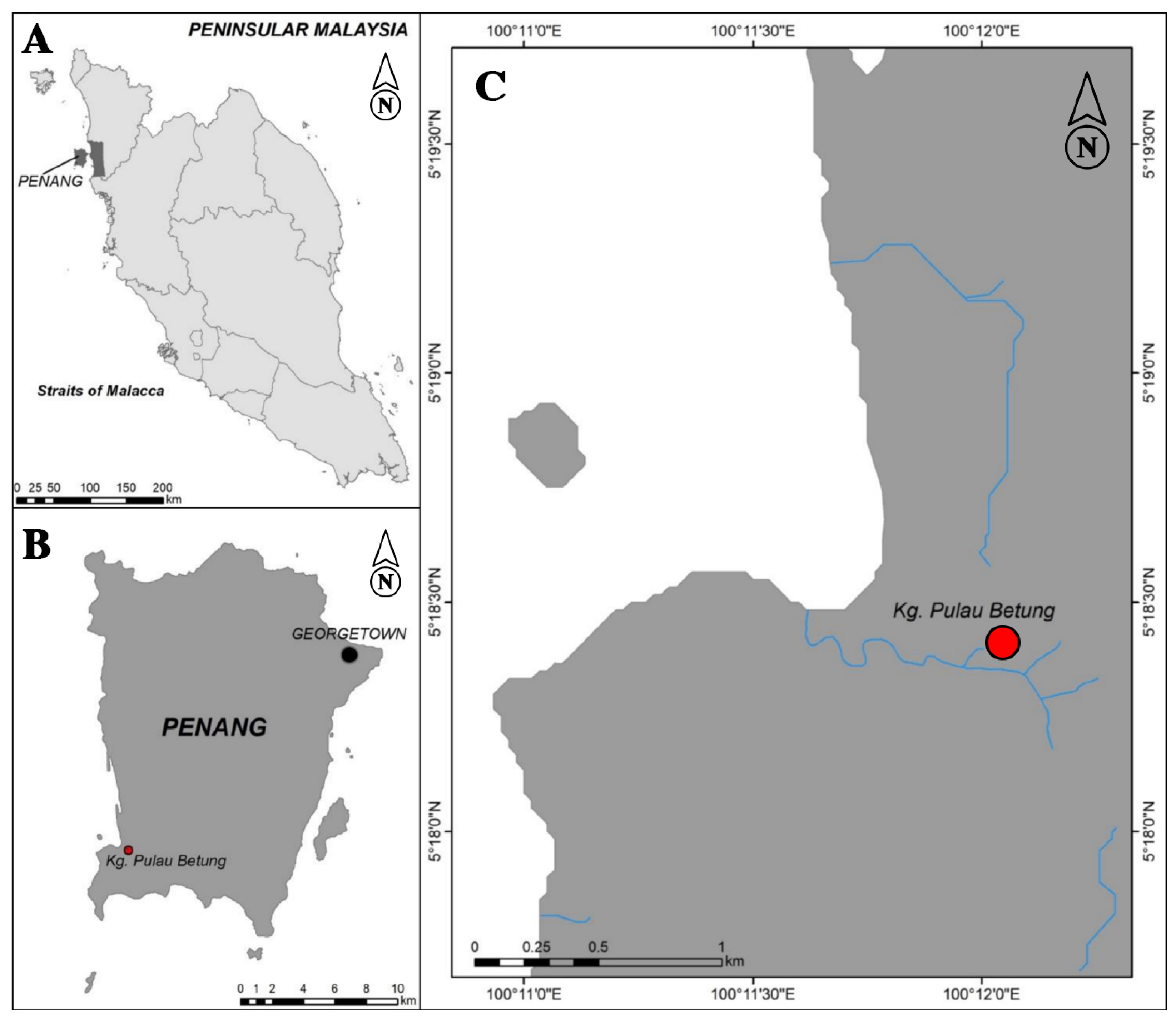
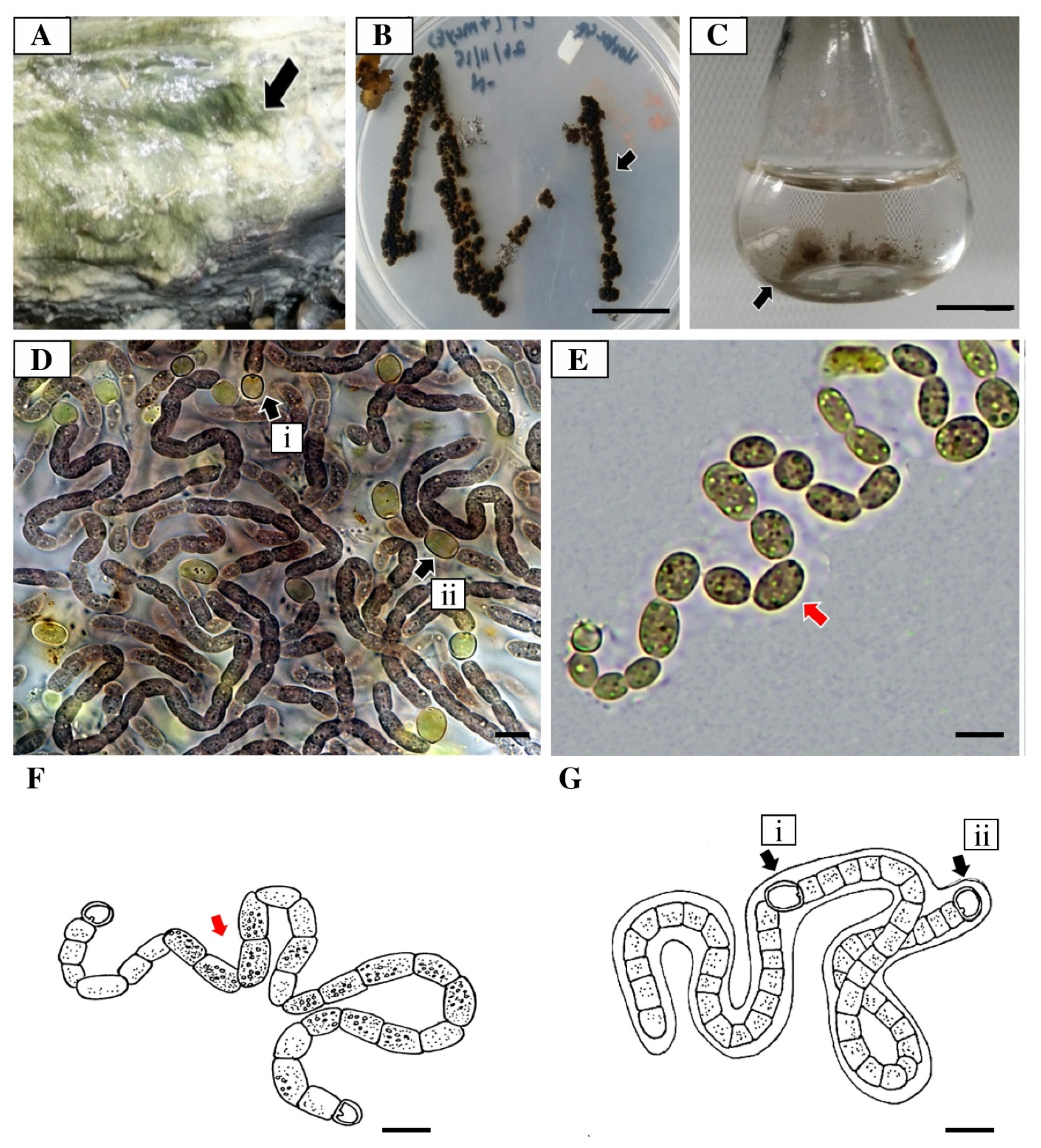

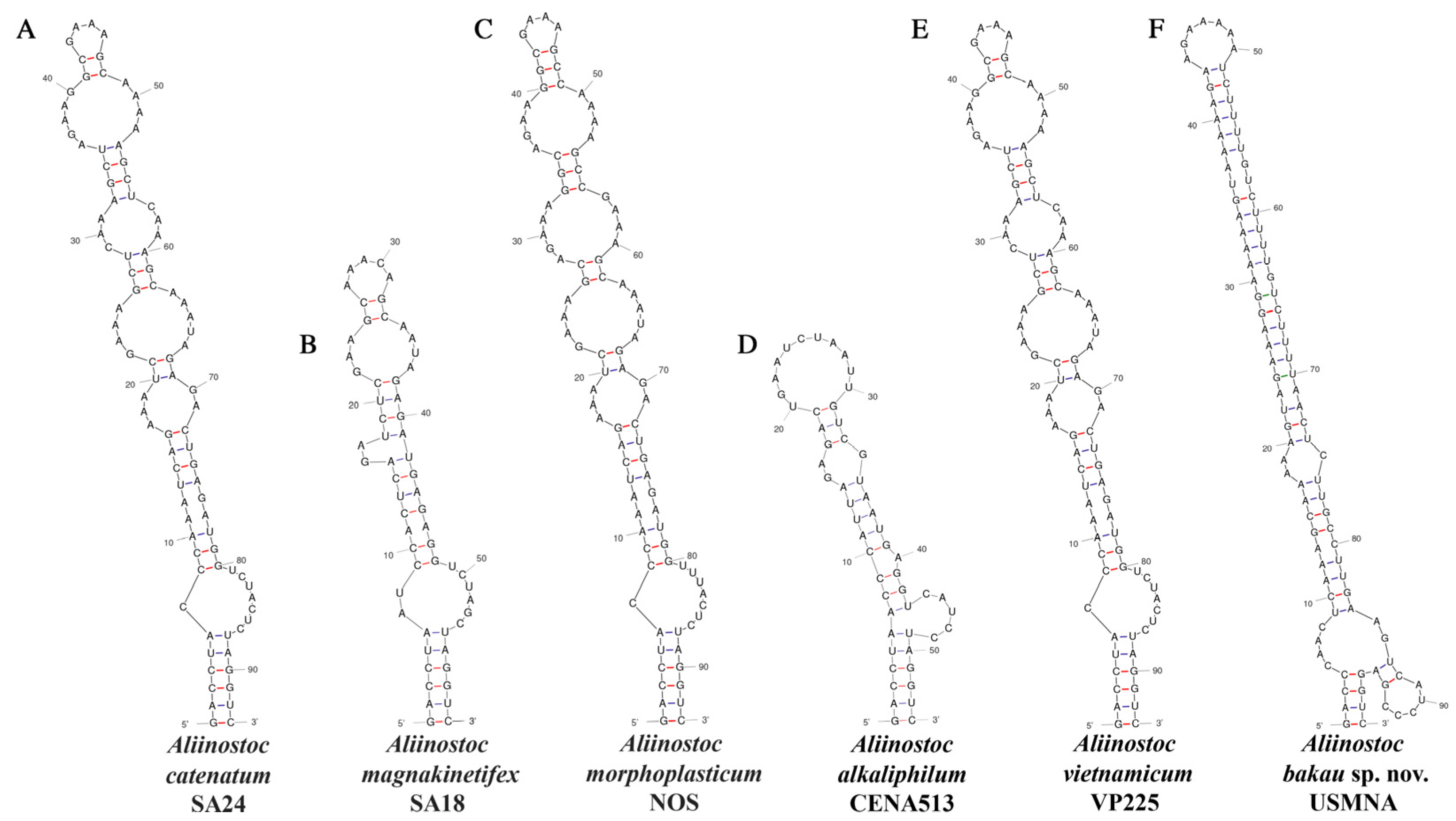
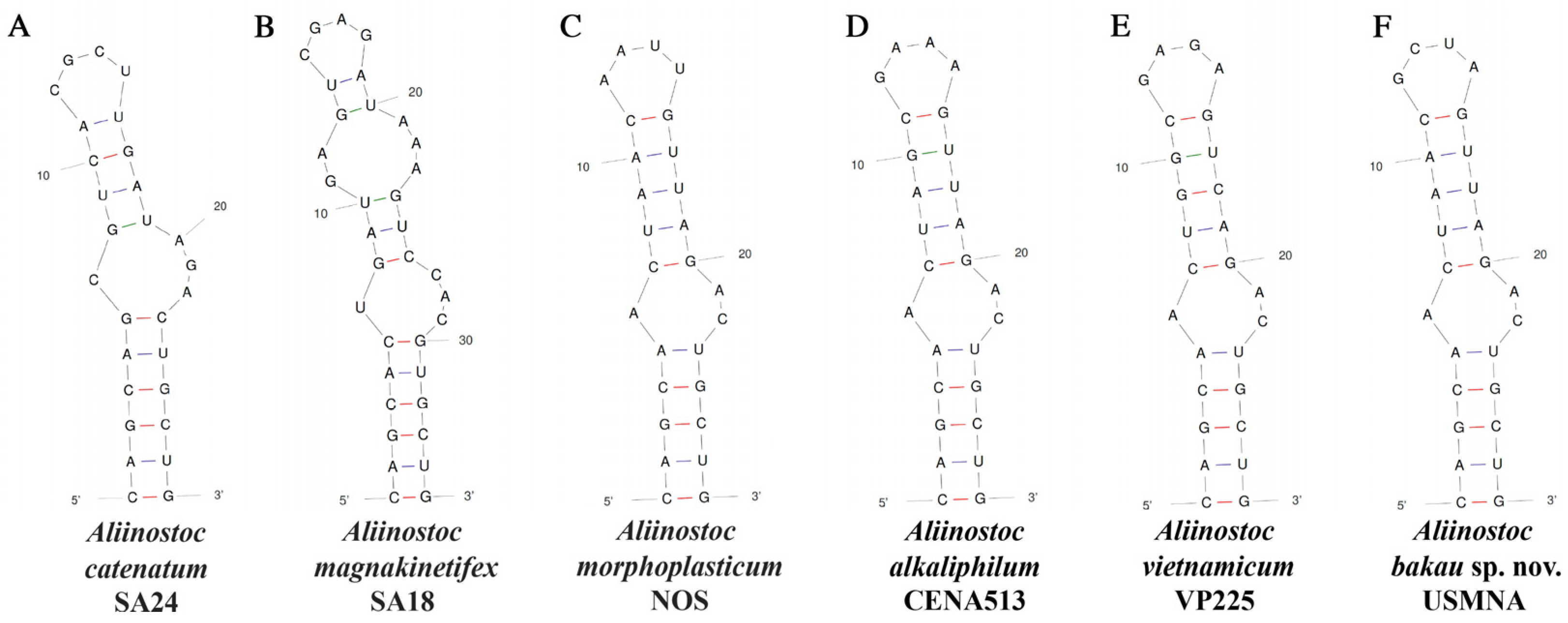
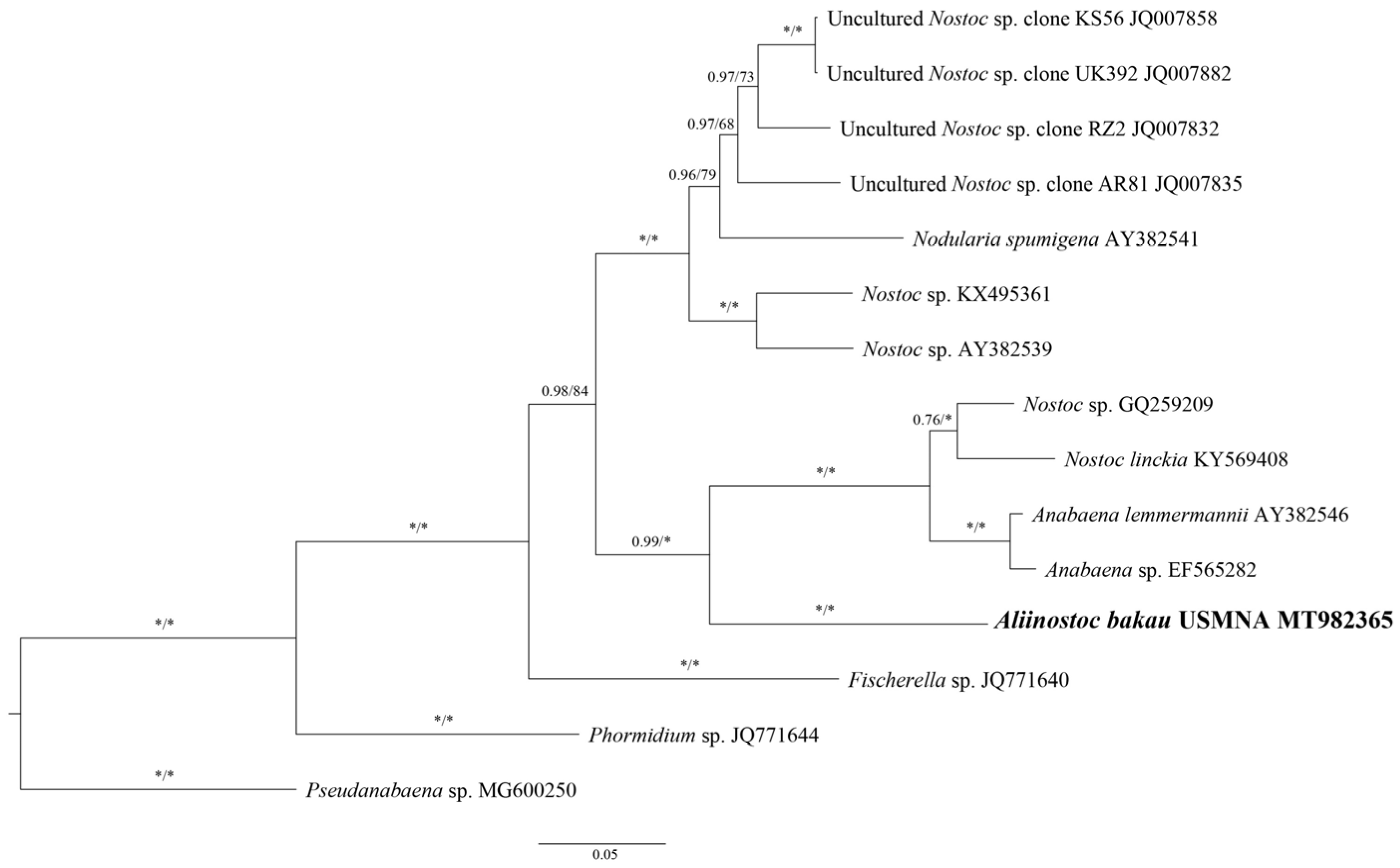
| Characters | Aliinostoc bakau sp. nov | Aliinostoc morphoplasticum [47] | Aliinostoc magnakinetifex [48] | Aliinostoc catenatum [48] | Aliinostoc alkaliphilum [51] | Aliinostoc vietnamicum [52] |
|---|---|---|---|---|---|---|
| Macroscopic appearance in the environment | No visible colonies observed in the original collection | Spherical colonies forming yellowish-brown leathery mats | Discrete mucilaginous greenish-blue colonies | Thick mucilaginous greenish-blue mats | Does not form macroscopic mats in nature, planktic with dark brown cells | Irregular flake-like, loose mucilaginous-textured, gray or gray-blue colonies without periderm |
| Colony characteristics in cultures | Dark brownish-green colonies (on agar plates) and brown jelly-like amorphous colonies (in liquid medium) | No data available | No data available | No data available | Dark brown, irregular, without distinct periderm (on agar plates) and tiny clusters of filaments loosely attached to bottom (in liquid medium) | No data available |
| Cell length (µm) | 3.8–7.5 | 2.6–5.2 | 1.4–4.3 | 3.2–9.5 | (3.3) 3.5–6.6 | 4.0–5.0 |
| Cell width (µm) | 2.0–3.5 | 2.7–3.8 | 2.9–4.1 | 2.4–4.0 | 2.6–3.5 | 2.5–3.0 or 2.2–3.7 in diameter |
| Vegetative cell shape | Barrel-shaped to cylindrical, longer than wide | Barrel-shaped to spherical to oblong, isodiametric, barrel-shaped | Spherical to square and even cylindrical, isodiametric, longer than wide | Barrel-shaped to cylindrical, longer than wide | Cylindrical with rounded ends, oval or barrel-shaped | Barrel-shaped, spherical to cylindrical |
| Cross wall | Constricted at cross wall | Distinctly constricted at cross wall | Distinctly constricted at cross wall | Constricted at cross wall | Constricted at cross wall | Constricted at cross wall |
| Heterocyst shape | Spherical to cylindrical | Spherical to elliptical to ovate and oblong | Spherical to cylindrical | Spherical to cylindrical | Spherical to cylindrical to oblong or oval | Spherical to oval to cylindrical |
| Heterocyst length (µm) | 5.0–6.4 | 3.7–5.7 | 2.5–5.5 | 3.0–10.2 | 3.9–7.0 (7.4) | 6.2–8.0 |
| Heterocyst width (µm) | 3.8–5.0 | 3.2–4.0 | 2.5–5.1 | 3.2–5.5 | (2.8) 3.1–5.0 (5.7) | 4.7–6.0 or 3.0–5.7 in diameter |
| Sheath | Individual, thin hyaline | Individual, hyaline | Individual, hyaline | Individual, slightly coloured | Individual, thin, colourless | Individual, lightly coloured |
| Akinete | Present | Present | Present | Present | Present | Present |
| Akinete shape | Broadly ellipsoidal | Oblong | Spherical | Oval | Spherical to oval | Spherical to oval or oblong |
| Akinete length (µm) | 5.0–7.5 | 5.7–6.1 | 6.3–10.1 | 3.4–11.3 | No data available | 6.4–8.0 |
| Akinete width (µm) | 4.0–6.5 | 4.5–4.7 | 5.2–8.4 | 3.3–6.4 | up to 12 | 5.7–6.6 |
| Hormogonia | Absent | Present with gas vesicles | Present | Present | Present with gas vesicles | Present with gas vesicles |
| Hormogonia motility | - | Motile | No data available | No data available | Motile | Motile |
| Occurrence | Mangrove on rotten tree branch | A stagnant, eutrophic-polluted pond | Garden soil | Garden soil | Alkaline brackish water | Tropical forest soil |
Disclaimer/Publisher’s Note: The statements, opinions and data contained in all publications are solely those of the individual author(s) and contributor(s) and not of MDPI and/or the editor(s). MDPI and/or the editor(s) disclaim responsibility for any injury to people or property resulting from any ideas, methods, instructions or products referred to in the content. |
© 2023 by the authors. Licensee MDPI, Basel, Switzerland. This article is an open access article distributed under the terms and conditions of the Creative Commons Attribution (CC BY) license (https://creativecommons.org/licenses/by/4.0/).
Share and Cite
Merican, F.; Abdul Rahim, N.A.; Zaki, S.; Siti Azizah, M.N.; Broady, P.; Convey, P.; Lim, B.; Muangmai, N. Aliinostoc bakau sp. nov. (Cyanobacteria, Nostocaceae), a New Microcystin Producer from Mangroves in Malaysia. Diversity 2024, 16, 22. https://doi.org/10.3390/d16010022
Merican F, Abdul Rahim NA, Zaki S, Siti Azizah MN, Broady P, Convey P, Lim B, Muangmai N. Aliinostoc bakau sp. nov. (Cyanobacteria, Nostocaceae), a New Microcystin Producer from Mangroves in Malaysia. Diversity. 2024; 16(1):22. https://doi.org/10.3390/d16010022
Chicago/Turabian StyleMerican, Faradina, Nur Afiqah Abdul Rahim, Syazana Zaki, Mohd Nor Siti Azizah, Paul Broady, Peter Convey, Billy Lim, and Narongrit Muangmai. 2024. "Aliinostoc bakau sp. nov. (Cyanobacteria, Nostocaceae), a New Microcystin Producer from Mangroves in Malaysia" Diversity 16, no. 1: 22. https://doi.org/10.3390/d16010022
APA StyleMerican, F., Abdul Rahim, N. A., Zaki, S., Siti Azizah, M. N., Broady, P., Convey, P., Lim, B., & Muangmai, N. (2024). Aliinostoc bakau sp. nov. (Cyanobacteria, Nostocaceae), a New Microcystin Producer from Mangroves in Malaysia. Diversity, 16(1), 22. https://doi.org/10.3390/d16010022










